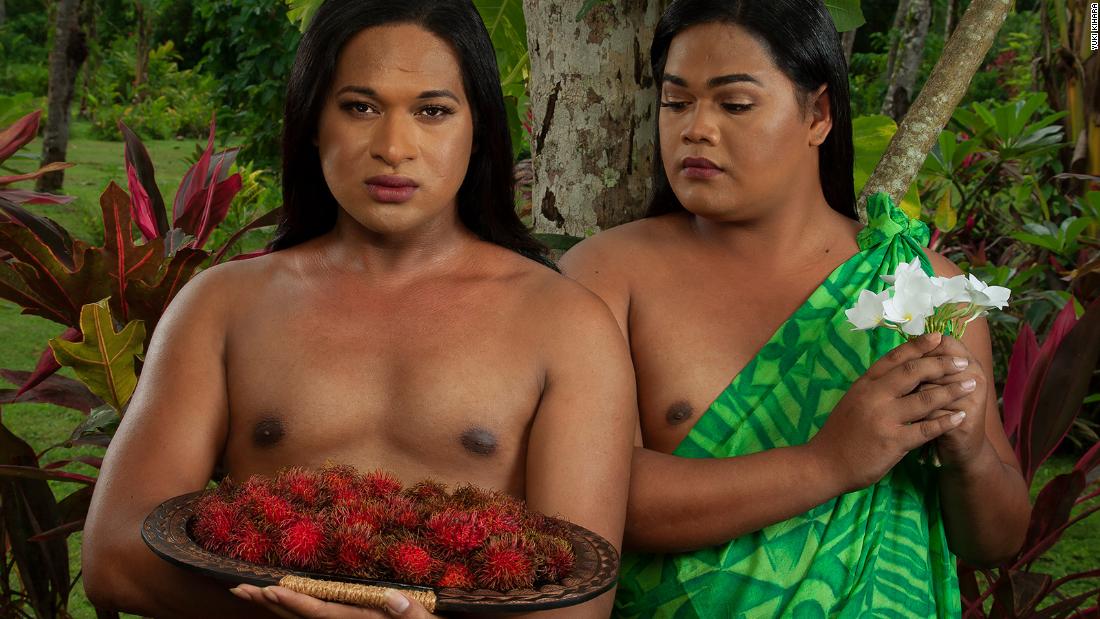
On an early morning in 2008, earlier than the Metropolitan Museum of Artwork opened for the day, the artist Yuki Kihara sat down throughout from two artwork through the French artist Paul Gauguin and inspected them within the hushed, empty gallery.
The Eastern and Samoan artist, who used to be displaying on the New York museum on the time, used to be specifically inquisitive about “Two Tahitian Ladies,” from 1899, which options two female figures in an Eden-like atmosphere. One holds a flower and leans into her significant other, who gifts a tray of fruit to the viewer, however does not fairly glance as much as meet the attention. Fourteen years after first seeing it, Kihara has “upcycled” — or reinterpreted — the portray, together with lots of Gauguin’s different artistic endeavors, in a images sequence titled “Paradise Camp” for the Venice Biennale.
“It isn’t like reenactment or restaging, as a result of once I say ‘upcycling,’ it implies that I am in fact making improvements to it from the unique,” Kihara stated in a video name.
Kihara is the primary Pacific Indigenous artist from Samoa’s Fa’afafine group — who’re assigned male at beginning however specific a feminine id — to constitute New Zealand on the prestigious international artwork display. In “Paradise Camp,” curated through Natalie King, Kihara intertwines subject matters of LGBTQ+ rights, environmentalism, and decolonization. In her lush pictures, taken on Upolu Island in Samoa with a just about 100-person solid and staff, she casts Fa’afafine within the starring roles, preserving the familiarity of Gauguin’s compositions however losing his exploitative standpoint.

“Two Tahitian Ladies,” from 1899, through Paul Gauguin. Credit score: Paul Gauguin, Courtesy Metropolitan Museum of Artwork
Uncovering and upcycling
How true are Gauguin’s works and what kind of is built? To Kihara, the scenes, supposedly set in Tahiti, felt all too acquainted.
“The nearer I regarded on the background, after which the nearer I regarded on the fashions, it jogged my memory of other people and puts in Samoa,” she stated.
Via her intensive analysis of colonial images, Kihara has discovered a transparent hyperlink to the archipelago — particularly during the pictures of Thomas Andrew, a New Zealand photographer who lived in Samoa for the latter part of his existence, from 1891 till 1939. Kihara came upon compositions similar to Gauguin’s paintings, in addition to proof that Gauguin in 1895 visited the Auckland Artwork Gallery, the place a few of Andrew’s pictures had been housed.
“Even supposing Gauguin hasn’t ever in fact set foot in Samoa, a few of his main artwork had been in fact at once impressed through pictures of other people and puts (there),” she stated.
With those connections in thoughts, Kihara got down to toughen upon Gauguin’s well-known works from a Pacific standpoint. In her take at the portray “Two Tahitian Ladies,” known as “Two Fa’afafine (After Gauguin),” the 2 Faʻafafine fashions stand in entrance of the manicured gardens of a neighborhood lodge dressed in conventional textiles. Kihara selected to characteristic native wildflowers and a plate of rambutan as their props, growing an altogether new iconography.
In keeping with Kihara, her portrait demanding situations the very idea of paradise. “The theory of paradise is in fact heteronormative,” she stated, referencing the Bible’s Lawn of Eden, house to Adam and Eve. In well-known literature and artwork, in addition to business imagery of honeymooning newlyweds, “paradise has been perpetuated through many of us, together with Paul Gauguin,” she stated. “He comes from a canon of (the) Western gaze that impose this concept.”
Calling a spot paradise additionally glosses over the complexities of the apparently idyllic areas the place vacationers commute to flee, she added, together with the land’s historical past of colonial violence and the looming risk of local weather crisis, a fight through which Samoa is at the entrance traces.
After the Biennale concludes, Kihara plans to show off the paintings for her personal group in Samoa, New Zealand and Australia.
“I am taking the integrity and the honor again to the place it belongs to us, within the Pacific,” she stated.
